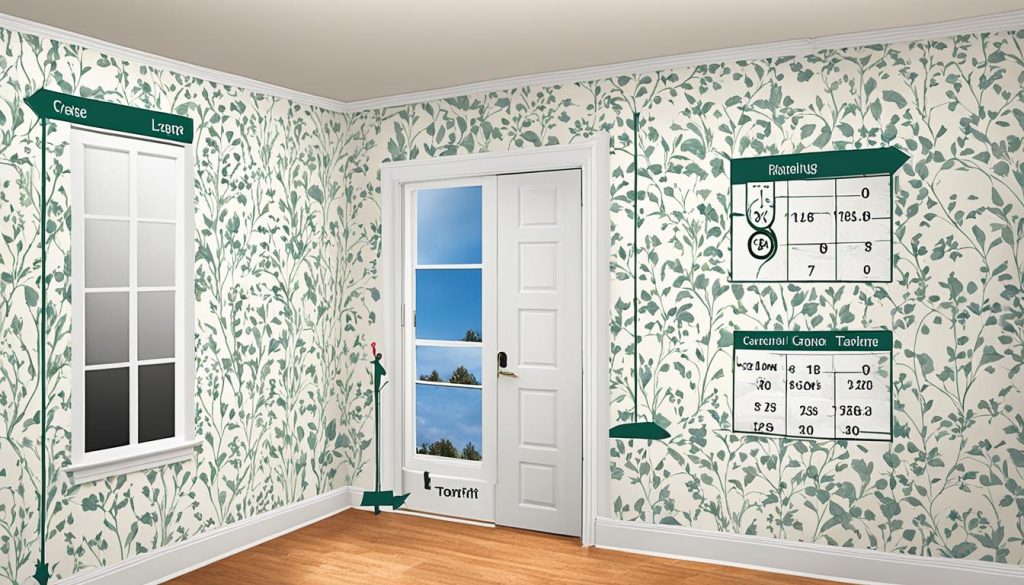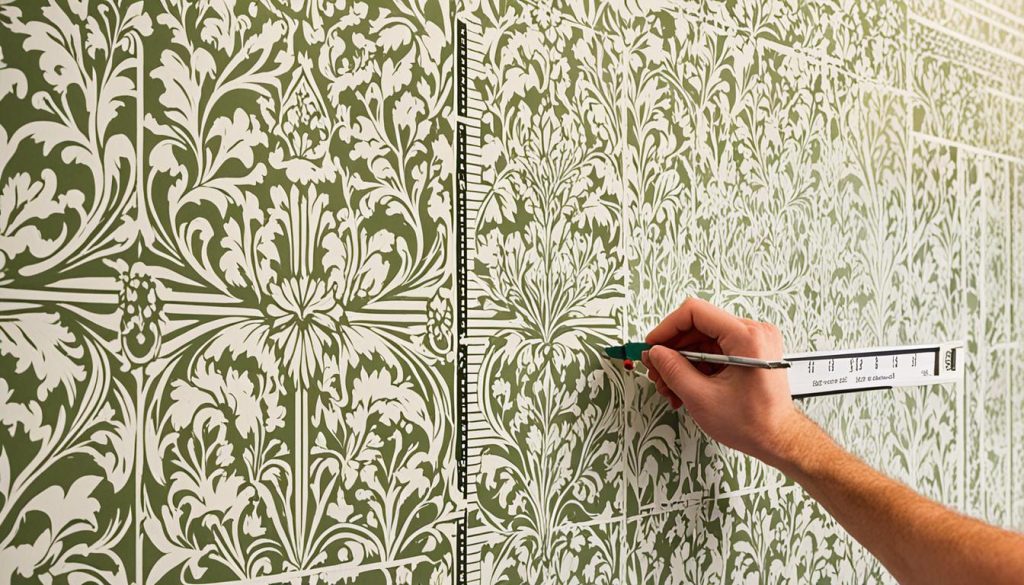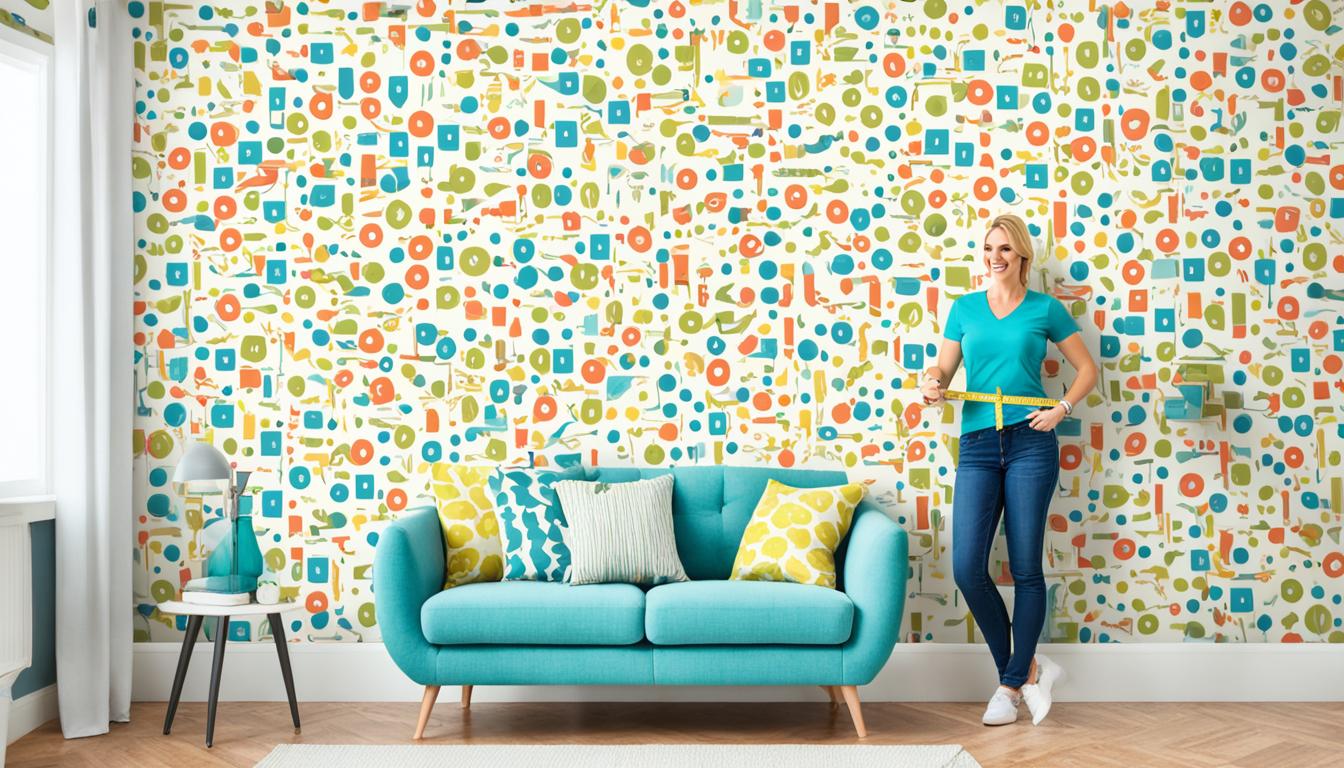When it comes to transforming your walls with wallpaper, accurate measurements are crucial for achieving a seamless and professional-looking result. Whether you’re a first-time DIYer or a seasoned pro, knowing how to measure for wallpaper can save you from costly mistakes and ensure you have just the right amount of wallpaper for your project.
In this easy guide, I will walk you through the step-by-step process of measuring for wallpaper, providing you with essential tips and tricks along the way. From calculating square footage to dealing with complex patterns, you’ll learn all the necessary techniques to make your wallpaper installation a breeze.
Key Takeaways:
- Accurate measurements are essential for successful wallpaper installation.
- Multiply the width and height of each wall to calculate square footage.
- Account for pattern repeats and order from the same batch to ensure consistency.
- Consult with a decorator if needed to avoid common measuring mistakes.
- Ordering slightly more wallpaper than required can prevent running out in the middle of the project.
Measuring the Walls
When it comes to wallpaper installation, accurate measurements are crucial for achieving a seamless and professional look. To ensure a perfect fit for your wallpaper, follow these steps to measure your walls accurately.
- Use a metal tape measure: To obtain precise measurements, it’s important to use a metal tape measure rather than a flexible ruler or tape. This will help avoid any errors caused by bending or stretching.
- Measure the width: Start by measuring the width of each wall where you plan to install the wallpaper. Begin from one corner to the other, making sure to measure at the widest point. Write down the measurement for each wall.
- Measure the height: Next, measure the height of each wall from the floor to the ceiling. Again, measure at the highest point to ensure accurate dimensions. Note down the measurement for each wall.
- Exclude baseboards: Unless you plan on wallpapering over your baseboards, remember to exclude them from your measurements. This will help you calculate the exact amount of wallpaper needed without any wastage.
Now that you have measured the width and height of your walls, you can move on to the next step: calculating the dimensions and determining the amount of wallpaper needed for your project.
Calculating Square Footage
One of the most crucial steps in determining the amount of wallpaper you’ll need is calculating the square footage of your walls. This measurement will help you order the right quantity and avoid over-ordering, saving you time and money.
To calculate the square footage, you’ll need to multiply the width and height of each wall. Use a metal tape measure for accurate measurements, ensuring the numbers are as precise as possible. Write down the measurements for each wall to keep track of them. Remember, exclude the baseboards from your measurements unless you plan on wallpapering over them.
Once you have the square footage for each wall, add them together to get the total square footage of the room. This sum will be the basis for determining how much wallpaper you’ll need to order. However, it’s important to subtract the square footage of any doors and windows from your calculations. By excluding these areas, you can ensure that you order the right amount of wallpaper for the surfaces you plan to cover.
If you’re unsure about the calculations or need assistance, consider consulting with a professional decorator or seeking guidance from the wallpaper supplier. They can provide valuable insights and help you determine the correct square footage for your project, ensuring a smooth and successful wallpaper installation.
| Wall | Width (feet) | Height (feet) | Square Footage (feet²) |
|---|---|---|---|
| Wall 1 | 10 | 8 | 80 |
| Wall 2 | 12 | 8 | 96 |
| Wall 3 | 10 | 8 | 80 |
| Wall 4 | 12 | 8 | 96 |
| Total | 352 |
Example table illustrating the calculation of square footage for each wall and the total square footage of the room.
Determining the Number of Rolls
Once you have calculated the total square footage of the room, the next step is to determine the number of rolls of wallpaper you will need. Each roll covers a certain square footage, so dividing the total square footage by the square footage covered by each roll will give you the answer.
It’s always recommended to get more wallpaper than you think you will need. This is important to account for waste during installation and to ensure that you have enough to complete the project without any interruptions.
By ordering extra wallpaper, you can be confident that you have sufficient material to handle any unforeseen challenges that may arise during the installation process.
To ensure accuracy in determining the number of rolls, consult the product specifications for the coverage area per roll. This information is typically provided by the manufacturer and will guide you in making the most precise calculation for your specific wallpaper.
Example Calculation:
Let’s say you have calculated the total square footage of your room to be 350 square feet, and each roll of wallpaper covers 25 square feet.
To determine the number of rolls you will need:
Number of rolls = Total square footage / Square footage covered by each roll
Number of rolls = 350 square feet / 25 square feet = 14 rolls
So, in this example, you would need to order 14 rolls of wallpaper to complete your project.

| Room | Wall Measurements (feet) | Square Footage |
|---|---|---|
| Living Room |
|
400 |
| Bedroom |
|
560 |
| Total | 960 |
In the table above, we have two rooms with their respective wall measurements and calculated square footage. The total square footage for both rooms is 960. Based on this total square footage and the coverage provided by each roll, you can accurately determine the number of rolls needed for your wallpaper project.
Remember to account for waste and keep extra rolls on hand to ensure a seamless and stress-free installation.
Dealing with Complex Patterns
If you’ve chosen a wallpaper with a complex pattern that needs to match up horizontally and vertically, there are a few additional considerations to keep in mind. One important factor is determining the pattern repeat.
The pattern repeat refers to the distance between the matching parts of the pattern. It’s crucial to take this into account when measuring for wallpaper, as it can impact the amount of wallpaper you’ll need to achieve a seamless look.
To determine the pattern repeat, examine the wallpaper closely and identify where the pattern aligns. Measure the distance between these matching points to find the pattern repeat measurement.
Once you have determined the pattern repeat, you can calculate the total square footage required by multiplying the pattern repeat by the number of rolls needed. This will ensure you have enough wallpaper to align the pattern correctly and achieve a visually stunning result.
Navigating complex patterns may require additional precision and patience, but the end result is well worth the effort.
Take a look at the image below to visualize how the matching parts of a complex pattern should align:

| Dealing with Complex Patterns | |
|---|---|
| Step 1 | Determine the pattern repeat by measuring the distance between matching points of the pattern. |
| Step 2 | Multiply the pattern repeat by the number of rolls needed to calculate the total square footage required. |
| Step 3 | Ensure precise alignment of the pattern to achieve a seamless look. |
Order from the Same Batch
When measuring for wallpaper accurately, it’s crucial to ensure consistent color throughout the room. To achieve this, it’s important to order all the wallpaper you need at the same time from the same batch. This step is often overlooked but can make a significant difference in the final result.
Wallpaper is manufactured in batches, and there may be slight variations in color and texture between different batches. If you were to order wallpaper from different batches, it could result in noticeable color shifts on your walls. This can be especially problematic when certain lighting conditions highlight these variations.
To avoid any inconsistencies, it’s best to order all your wallpaper from a single batch. This will guarantee a cohesive look and ensure that every roll has the same shade, pattern alignment, and overall appearance.
By ordering from the same batch, you also minimize the risk of running out of wallpaper in the middle of your project. It’s always better to have a little extra wallpaper left over than not enough.
When browsing through wallpaper options, make sure to note the batch number or run number associated with each design. This will help you ensure consistency when placing your order.
Ordering from the same batch may require careful planning and estimation, but the end result will be a visually appealing room with a seamless wallpaper application. Remember to include this step in your wallpaper sizing guide to achieve professional-looking results.
Avoiding Common Mistakes
When it comes to measuring for wallpaper, there are some common mistakes that you’ll want to avoid to ensure a smooth installation process and a flawless result. By keeping these tips in mind, you can save time, money, and frustration.
One common mistake is not accounting for pattern repeats. Many wallpapers have intricate patterns that need to match up seamlessly. It’s important to determine the pattern repeat and calculate the total square footage required accordingly. If you overlook this step, you may end up with gaps or mismatched patterns.
Another mistake is confusion over single vs. double rolls. Wallpaper is typically sold in either single or double rolls, and it’s crucial to know the difference. Single rolls cover approximately 25 square feet, while double rolls cover around 50 square feet. Failing to understand this distinction can lead to ordering too much or too little wallpaper.
Lastly, many people forget to measure windows and doors when calculating the amount of wallpaper needed. These areas should be taken into account to avoid running out of wallpaper or purchasing more than necessary. It’s always better to have a bit of extra wallpaper than to fall short during installation.
